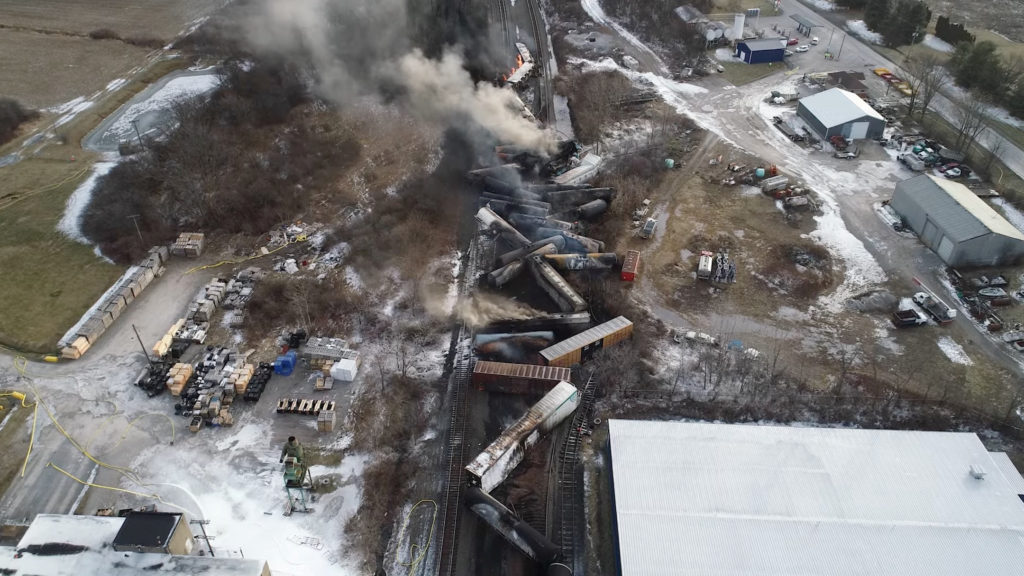Months-Long Lingering Of Toxic Chemicals In Buildings After Ohio Train Derailment

Table of Contents
The Toxic Cocktail: Identifying the Persistent Chemicals
The Ohio train derailment spilled a dangerous cocktail of toxic chemicals, many of which are known to persist in the environment and pose significant health risks. Understanding the specific chemicals and their properties is crucial to assessing the long-term consequences of this disaster. Key persistent chemicals released include:
- Vinyl chloride: A known human carcinogen, vinyl chloride exposure is linked to liver cancer, brain cancer, and other serious health problems. Its volatile nature means it readily evaporates and can infiltrate buildings through air infiltration.
- Butyl acrylate: This chemical is an irritant to the eyes, skin, and respiratory system. Long-term exposure can cause more severe health issues including allergic reactions and potentially respiratory illnesses. Its persistence in porous materials is a significant concern.
- Ethylene glycol monobutyl ether: Exposure to this chemical can cause kidney and nervous system damage. Its presence in contaminated water sources poses a significant risk.
- Ethylhexyl acrylate: This chemical is also a respiratory irritant and can cause skin and eye irritation. Its persistence in fabrics and other building materials adds to the long-term contamination problem.
These persistent organic pollutants (POPs) can linger in various building materials, including porous surfaces like carpets and drywall, fabrics, and HVAC systems. Their potential to leach into indoor air and water supplies poses a continuing threat to human health.
Pathways of Contamination: How Chemicals Infiltrate Buildings
The pathways through which these toxic chemicals infiltrated buildings are multifaceted and complex, leading to widespread contamination. Understanding these pathways is essential for effective remediation.
- Air Contamination: Airborne chemicals entered buildings through numerous routes: open windows, inadequate ventilation systems, cracks in building structures, and even through HVAC systems. The initial plume spread widely, and the volatile nature of some chemicals allowed for significant indoor air contamination.
- Water Contamination: Contaminated soil and groundwater can lead to the migration of chemicals into building foundations and interior spaces. This is especially concerning for homes and buildings with basements or direct contact with the ground. Water contamination can affect drinking water supplies and even lead to indoor water damage that spreads contamination further.
- Soil Contamination: Chemicals absorbed into the soil can slowly leach into building foundations and interior spaces over time. This process is influenced by factors such as soil type, groundwater levels, and the specific chemicals involved. The long-term implications of soil contamination require extensive and ongoing monitoring.
- Surface Contamination: Direct contact with contaminated surfaces, such as soil or contaminated debris, can lead to the transfer of chemicals onto building materials like carpets, drywall, and furniture. This direct contamination further contributes to indoor pollution.
Long-Term Health Effects: The Silent Threat
Exposure to the complex mixture of toxic chemicals released during the Ohio train derailment presents a serious threat of long-term health consequences for affected communities.
- Cancer Risk: Many of the chemicals released are known carcinogens, increasing the risk of various cancers, particularly those affecting the liver, brain, and respiratory system. Long-term monitoring is crucial to assess the full extent of cancer risk.
- Respiratory Illness: Exposure to irritants like butyl acrylate and ethylhexyl acrylate can cause a range of respiratory problems, from acute irritation to chronic conditions like asthma and bronchitis. Long-term respiratory issues are a major concern for residents.
- Reproductive Health: Some chemicals can interfere with hormone function and reproductive health. Potential long-term effects on fertility and developmental health require detailed investigation and monitoring.
- Neurological Damage: Exposure to certain chemicals can cause neurological damage, leading to a range of problems, from cognitive impairment to more serious neurological disorders. The long-term implications of neurotoxic exposure require thorough assessment.
The complexity of the chemical mixture and the delayed onset of some health problems pose significant challenges in assessing the full long-term health impact. Establishing robust long-term health monitoring programs for affected communities is critical.
Mitigation and Remediation Strategies: Protecting Communities
Addressing the lingering contamination requires a comprehensive and multi-pronged approach focusing on remediation and protecting public health.
- Building Remediation: This involves removing or neutralizing contaminated building materials, including carpets, drywall, and insulation. Air purification and filtration systems are also needed to improve indoor air quality.
- Air Purification: Specialized air filtration systems can remove many of the airborne pollutants from buildings. Proper ventilation strategies are also crucial to minimize further contamination.
- Water Purification: Ensuring safe and clean drinking water is paramount. This might involve water filtration systems, testing of water supplies, and potentially the remediation of contaminated water sources.
- Soil Remediation: Addressing soil contamination can involve excavating and removing contaminated soil, applying remediation technologies to break down or remove chemicals, or implementing strategies to prevent further migration.
- Community Support: Providing comprehensive medical monitoring, health education, and mental health support to affected communities is critical.
Government intervention and robust community support are crucial for coordinating these efforts and ensuring that affected communities have access to necessary resources.
Conclusion
The lingering presence of toxic chemicals in buildings months after the Ohio train derailment presents a serious and ongoing public health threat. The persistent nature of these substances, combined with their known health effects, necessitates immediate and comprehensive action. Understanding the pathways of contamination and implementing effective remediation strategies are crucial for protecting the health and well-being of affected communities. The long-term consequences of this environmental disaster demand sustained attention and resources.
Call to Action: Demand accountability and action to address the lingering effects of the Ohio train derailment’s toxic chemicals in buildings. Support organizations working to provide health monitoring and remediation services to affected communities and advocate for stricter regulations to prevent future environmental disasters. Learn more about the long-term health impacts of chemical exposure and how you can support those affected.

Featured Posts
-
 Deciphering The Liberal Platform A Critical Analysis By William Watson
Apr 24, 2025
Deciphering The Liberal Platform A Critical Analysis By William Watson
Apr 24, 2025 -
 Israeli Beach Years Of Shark Sightings Culminate In Tragedy
Apr 24, 2025
Israeli Beach Years Of Shark Sightings Culminate In Tragedy
Apr 24, 2025 -
 Herro Wins Thrilling Nba 3 Point Contest Defeats Hield In Close Final
Apr 24, 2025
Herro Wins Thrilling Nba 3 Point Contest Defeats Hield In Close Final
Apr 24, 2025 -
 E Bay Listings For Banned Chemicals Section 230 Protection Challenged
Apr 24, 2025
E Bay Listings For Banned Chemicals Section 230 Protection Challenged
Apr 24, 2025 -
 Sharp Drop In Teslas Q1 Profit Analysis Of The Contributing Factors
Apr 24, 2025
Sharp Drop In Teslas Q1 Profit Analysis Of The Contributing Factors
Apr 24, 2025
